Dorothea Lange: 10 of the most iconic portraits from a lost US
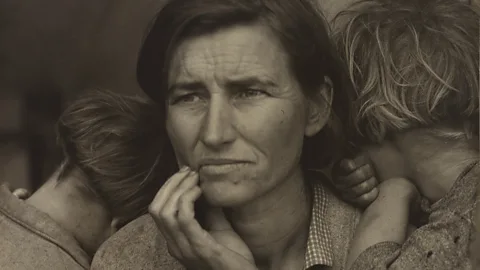 Dorothea Lange
Dorothea LangeAn exhibition at the National Gallery of Art in Washington explores the work of legendary photographer Dorothea Lange, who captured some of the most striking images ever shot of American poverty, hardship and resilience in the 20th Century.
Over the course of her 50-year career, Dorothea Lange created some of the most iconic photographs of the 20th Century. From White Angel, Breadline to her poignant works on Japanese Americans denied their rights during World War Two, Lange embodied the humanity of the people caught up in events beyond their control.
More like this:
- Photos that ask what it means to be American
Lange began her career as a studio photographer and first experimented outside the studio on trips with her then-husband, the artist Maynard Dixon. But it was the Great Depression that spurred her to turn to documentary photography. "In the early days of the Depression in San Francisco she began to see people in need on the streets. It was the experience of seeing something that was not right that made her go out and want to do something," says Philip Brookman, curator of Dorothea Lange: Seeing People at the National Gallery of Art in Washington. "She believed that photographs could help change people's minds."
Throughout her career it was Lange's "sense of empathy and ability to connect with people" that made her such a great photographer, says Brookman. He selects 10 of her key works for BBC Culture.
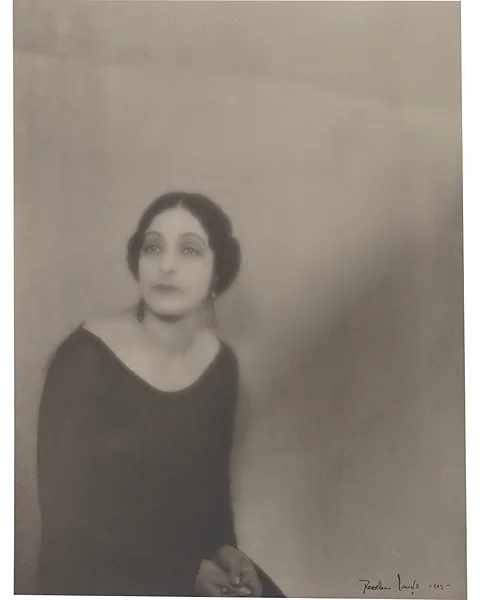 The Dorothea Lange Collection
The Dorothea Lange Collection1. Untitled (La Estrellita, "Spanish" Dancer), San Francisco, California, 1919
"What makes this exhibition different to previous Dorothea Lange exhibitions is that we wanted to show the impact of her early training and career as a studio portrait photographer on her social documentary works," says Brookman.
This portrait of Estrellita, who was an internationally famous vaudeville dancer before turning her hand to business, is one of Lange's earliest works. Although it adopts the traditional pictorial style of the era – using soft focus and soft tones to create a dreamlike quality – it also sees Lange experimenting with composition, positioning her subject to the far left of the pictorial frame, rather than simply focusing on her features. For Brookman "it conveys a sense of a person who is in transition. It's not her dressed as a Spanish dancer. It's a portrait of a woman who has become a businesswoman."
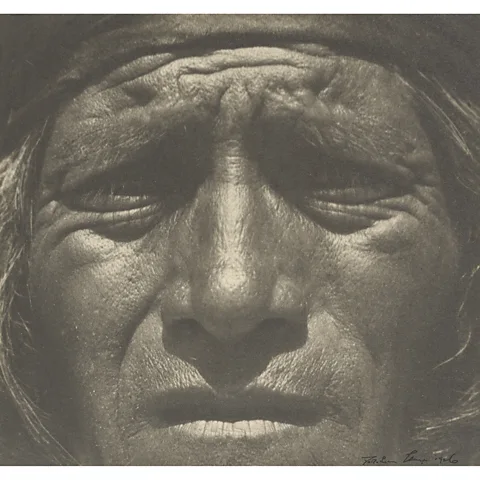 The Dorothea Lange Collection
The Dorothea Lange Collection2. Hopi Man, Arizona, 1923, printed 1926
Lange made Hopi Man when she was on a trip with her then-husband Maynard Dixon, a well-known painter of the American West. "This is the time when she was just beginning to photograph outside of her studio," explains Brookman. "She didn't make a lot of photos on those trips but the ones that have survived are really interesting. They're much more direct than her studio images."
The way in which Lange was beginning to experiment with the possibilities of portraiture is evident in the way she chose to closely crop the image when she printed it a few years later. "It's so tight on his face that it looks like a topographic mapping of his experience rather than just a picture of a person," says Brookman.
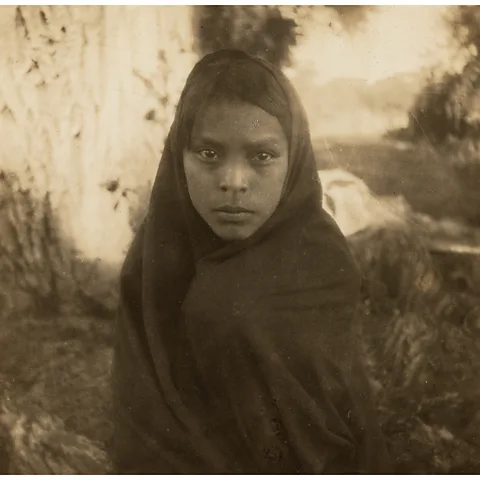 The Dorothea Lange Collection
The Dorothea Lange Collection3. Native American Girl, Taos, New Mexico, 1931
Native American Girl is one of a series of images of the same child that Lange took on a family trip with her husband and children. At the time Brookman thinks she was "experimenting with different ways to connect with people and make pictures that were more about that world and the culture she found." In this image Brookman sees a "really direct connection between Lange and the girl. There's a sense of understanding between them. She's looking right at the camera and seems pretty comfortable. There's a bond.
"I see this photograph as a transitional one that shows how Lange has been able to move outside the studio, and begin to transition to a more documentary form," says Brookman.
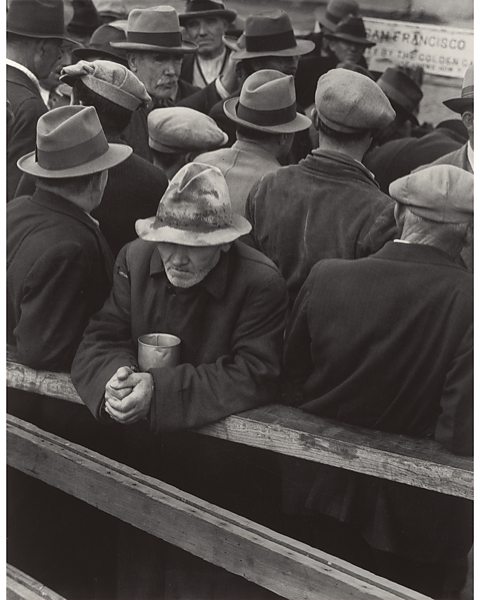 The Dorothea Lange Collection
The Dorothea Lange Collection4. White Angel Breadline, San Francisco, California, 1933
Although White Angel Breadline is often considered to be Lange's first documentary photograph, Brookman thinks otherwise. The exhibition hopes to emphasise that her experiments in a number of earlier images "lead to her full understanding of documentary practice," he says.
The image is notable "because it was made with this great intention. Lange was in her studio looking down, and saw so much poverty that she made a decision to consciously take her camera out of the studio on to the streets of San Francisco to document it," says Brookman.
This photograph, taken at the White Angel Jungle, a soup kitchen on the waterfront, was one of the first that she took. "It's become one of her most iconic, in part because of its simplicity," says Brookman.
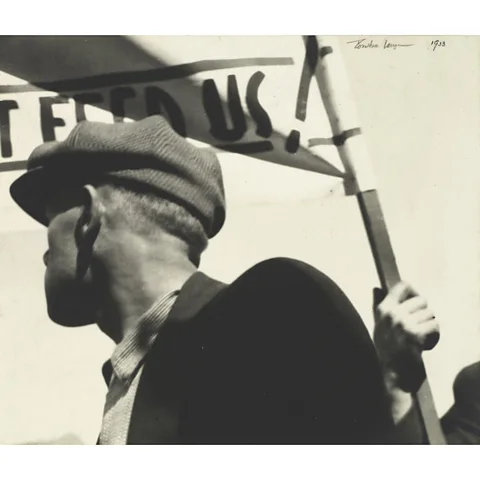 Dorothea Lange
Dorothea Lange5. Demonstration, San Francisco, 1934
Taken in the middle of the Great Depression, Demonstration reveals how "Lange began to use the situation to set up more information for us, like the words in the picture," explains Brookman.
Her empathy and respect for those that were suffering is evident in the way she began taking photographs from a lower angle at this time, giving her subjects a sense of stature. "She's not looking down on people. That angle gives them a power they might not otherwise have," says Brookman.
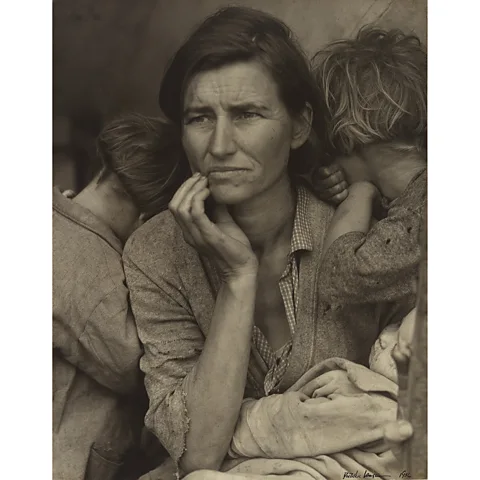 Dorothea Lange / The J Paul Getty Museum
Dorothea Lange / The J Paul Getty Museum6. Human Erosion in California (Migrant Mother), 1936
Although Human Erosion in California, better known as Migrant Mother, has become one of the most iconic photographic images of all time, it is not what it appears to be.
The image was one of a series of photos taken in a Pea Picker's camp in California when Lange was working for the Federal Resettlement Administration. Having come across the woman and her children in the camp, Lange spoke with them and posed them but didn't get their names. Brookman speculates that this may have been because Lange was tired after a long drive.
"I think she knew right away that this was a special sequence of photographs," says Brookman. Lange contacted the local press who agreed to publish one of the images in the sequence. When the State Government saw it, they immediately made aid available. "It was an indication of the power of a photograph," says Brookman.
However, after Lange's death it was discovered that the woman "was a full-blood Cherokee from Oklahoma. She was not a migrant worker," says Brookman. "The picture stands for something because of how Lange made it and how it was used but it is not true to who the woman was," says Brookman.
 Dorothea Lange / National Gallery of Art, Washington
Dorothea Lange / National Gallery of Art, Washington7. On the Plains a Hat is More than a Covering, 1938, printed c 1965
Brookman considers On the Plains a Hat is More than a Covering to be "an innovation in portraiture… I can see it as a portrait of a man but it doesn't show his face, it doesn't show his environment. It's about the character of the man, not just what he looks like."
Lange was clearly pleased with the image. She "made more traditional portraits of the same man, but this is the one she chose to print," says Brookman.
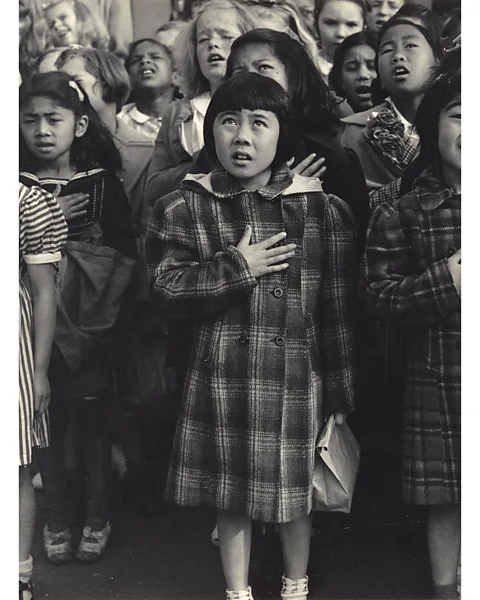 Dorothea Lange
Dorothea Lange8. Children of the Weill Public School Shown in a Flag Pledge Ceremony, San Francisco, California, April 1942, printed c 1965
Shortly after the US entered World War Two, Lange was hired by the War Relocation Authority to document Japanese Americans who were now seen as a potential danger and being forcibly relocated to incarceration camps. "I think Lange didn't agree with the policy. She agreed to work on the project so she could have access to show what was happening," says Brookman.
The poignant image of a Japanese-American girl standing alongside her classmates with her hand on her heart, earnestly pledging allegiance to the US flag, was taken before she and her family were incarcerated. "For me this is one of Lange's most important photographs. The innocence of an American child who is considered to be a threat," says Brookman.
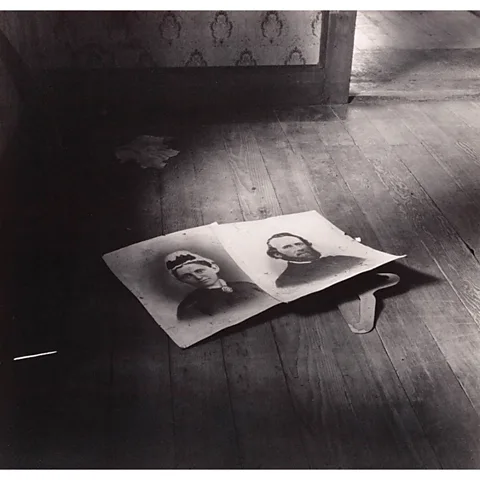 The Dorothea Lange Collection
The Dorothea Lange Collection9. Family Portrait, 1956
In the late 1950s Lange was working on an ultimately unpublished project for Life Magazine about the intentional flooding of a town in a valley in Northern California to make way for a dam to supply much-needed water to the area.
"It was an early environmental project that Lange was interested in. How the post-war boom caused so many people to come to California, but at a cost," says Brookman.
This picture was taken in a house before it was flooded but after it had been abandoned. "It's a poignant image that shows what is lost when an entire town is flooded. And what's lost is the memories of entire families," says Brookman.
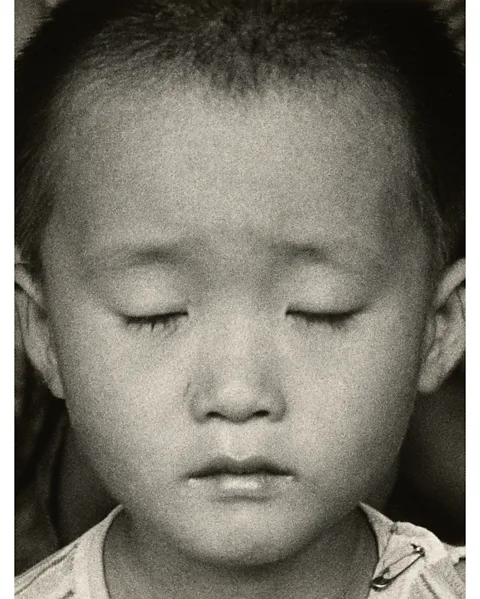 The Dorothea Lange Collection
The Dorothea Lange Collection10. Korean Child, 1958
Lange's emotive image of a young child's face was taken in South Korea five years after the end of the Korean War, when people were living in extreme poverty. "The actual picture shows a whole classroom of rambunctious children acting out for the camera and in the middle of the group is this boy with his eyes closed. He seems calmer and more at peace than the others," explains Brookman.
Lange focused in on the boy, creating different, closely cropped, images. "The closer she gets to his face, where you just see his features, the more it becomes a universal image," says Brookman. "To me it is a picture about the innocence of children in a world at war," he says. "These images are so relevant to us today."
Dorothea Lange: Seeing People is at the National Gallery of Art in Washington until 31 March 2024.
If you liked this story, sign up for The Essential List newsletter – a handpicked selection of features, videos and can't-miss news delivered to your inbox every Friday.
